‘Scars breaking out on the Peninsh*’, Honest History, 5 March 2015
Peter Stanley** reviews episodes 4 and 5 of Gallipoli (Channel 9). Reviews of episode 1, episode 2, episode 3, episodes 6 and 7.
Channel 9’s decision to ‘raise the white flag’, as Nelbie media and entertainment reporter Kevin Perry put it, to compress the Endemol Gallipoli’s season and play the remaining four episodes over two nights is a response to the production’s disappointing ratings on free-to-air commercial television. The ratings figures Perry analyses suggest that the series’ remaining viewers prefer (like me) to record the show and skip the numerous lengthy advertisements. This review covers episodes 4, ‘The deeper scar’, and 5, ‘The breakout’, though the decision to run the two episodes together meant that only the former title appeared on the screen. (Gallipoli fell out of the top twenty rating shows for these episodes screened on 2 March. We can’t find figures but we fear the worst. Correctly. )
While pondering the reasons for Gallipoli’s apparent failure I happened to re-watch Glory, a film I have seen periodically since its release in 1989. It also tells the story of four soldiers in one disastrous battle, only they were members of the 54th Massachusetts, a Union ‘coloured’ regiment that suffered colossal losses in the attack on Fort Wagner in 1863. Glory is a war film that gets just about everything right; not just the uniforms and the look, but the atmosphere, the relationships, even the emotional tone of what it felt like to face ‘minié’ balls and for black men to fight a white man’s war for black men’s freedom. It largely avoided easy answers, obvious tropes and dumb mistakes – except for cannons failing to recoil: why can’t they ever get that right?
What also worked for Glory, of course, was that it lasted just 120 minutes, not seven hour-long episodes. But Glory also operated under the burden of expectation – that the Civil War would be presented as a cause with which its original audience could still identify, as whites, as blacks, as Americans. Why did that not work for Endemol’s Gallipoli? Discuss.
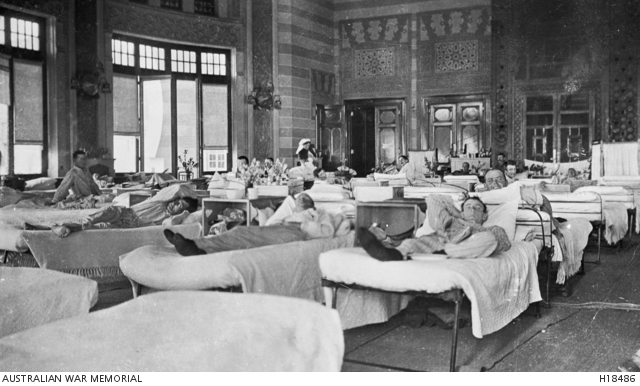 No 1 Australian Army General Hospital, Heliopolis Palace Hotel, Cairo, c. 1915 (Australian War Memorial H18486)
No 1 Australian Army General Hospital, Heliopolis Palace Hotel, Cairo, c. 1915 (Australian War Memorial H18486)
Episode 4 (and 5) opens with Tolly wounded in hospital in Egypt, a month or six weeks after the absurd ‘raid’ from Quinn’s Post. He stares vacantly as a nurse washes him, seemingly traumatised by his weeks of fighting on the peninsula. (I say seemingly because Kodi Smit-McPhee seems to have a one-size-fits-all gormless resting expression. It’s hard to work out what he’s supposed to be feeling.) The nurse is played by Gracie Gilbert, who at 22 at the time of filming was three years younger than the minimum age of sisters in the Australian Army Nursing Service. Like the actors who played the nurses in the ABC’s Anzac Girls, she is much more petite and attractive than nurses at the time, given their diet, occupational experience and lack of cosmetics, appear to be in their photographs. (Does no-one ask whether young women in 1915 actually used lipstick or plucked their eyebrows?)
At least writer Christopher Lee resisted the temptation to have the sister and Tolly hook-up (as they called it at the time, you might be surprised to learn). This was a wasted opportunity. Tolly comes across the sister (named on the Internet Movie Data Base as Tessa Gordon, for what it’s worth) weeping in a store-room, her apron covered in blood, clearly upset at a traumatic scene in the ward – a haemorrhage; a death. Rather than converse with her – giving her a voice and adding a female perspective to the drama – Tolly, true to his adolescent introversion, withdraws. Of course, we can imagine what nursing the casualties of Gallipoli means for her, but she remains mute.
Back at the Dardanelles, the theme of the war correspondents acting as a sort of Greek chorus continues. (A correction, though: IMDB has revised its mentions of Charles Bean: he’s now in five episodes, not two as it seemed a fortnight ago. But he still doesn’t get much to say; as in the reporting of the campaign Ellis Ashmead-Bartlett gets the lion’s share of the coverage.) This week we see Ashmead-Bartlett continue to act as the mouthpiece for those critical of the campaign (as he was). As in life, he brings with him from London a moving-picture camera, a ‘kinematograph’, which the script unfortunately has him calling a ‘cinematograph’. (This incident isn’t mentioned in Carlyon, though it is in my Quinn’s Post …) This opportunity is also largely wasted. Ashmead-Bartlett footles about with the instrument while the New Zealand colonel William Malone (see below) shows him the real war (but in trenches that are still much too shallow: couldn’t they have hired a bigger digger?) Sadly, the producers passed up the prospect of incorporating into the production some of Ashmead-Bartlett’s film – the only actual film shot on the peninsula in 1915.
This week’s Gallipoli offered a genuinely new inflection on the Gallipoli story. The character ‘Two Bob’, it is revealed in a midnight meeting with Tolly in hospital in Egypt, is Aboriginal – a ‘quarter caste’ as they would have said. This is historically justifiable. Although the AIF nominally accepted only men ‘substantially of European descent’, men of colour were accepted, if they could ‘pass’, as Two Bob did. Though it might seem like a nod to political correctness it is in fact a reflection of recent research that has shown that Indigenous men – a very few – reached Gallipoli as Anzacs. The quandary of Two Bob’s white mates agonising over how to properly bury a man (Two Bob is killed) who was not a Christian flops over into heartache more characteristic of our Australia than theirs. We have a deeper respect for Indigenous spirituality than was usual then. Whether white Australian men on Gallipoli would have understood, appreciated or respected such spirituality is highly dubious. The scene of them singing over Two Bob’s grave is just mawkish. (It’s also dreary in the weather too. I begin to wonder if the producers came to regret accepting Film Victoria’s support and a location on the Mornington Peninsula, because the overcast weather and frequent rain made the location look anything but like Gallipoli in mid-summer.)
Anyway, the impression of this new, multicultural Anzac is intensified when New Zealanders – William Malone’s Wellingtons – supposedly perform a haka before attacking at Chunuk Bair. This is invented: my New Zealand colleague, the Army Historian John Crawford, has never heard that such a thing happened. If it did, it comes seven or so decades before pakeha accepted or absorbed or adopted much of Maori culture. There were no Maori among the Wellingtons and Malone’s would no more adopt a Maori war chant than Tolly’s mates would have essayed a corroboree. The producers’ desire in this to project our cultural tolerance onto Australians and New Zealanders of 1915 has gone too far to be persuasive.
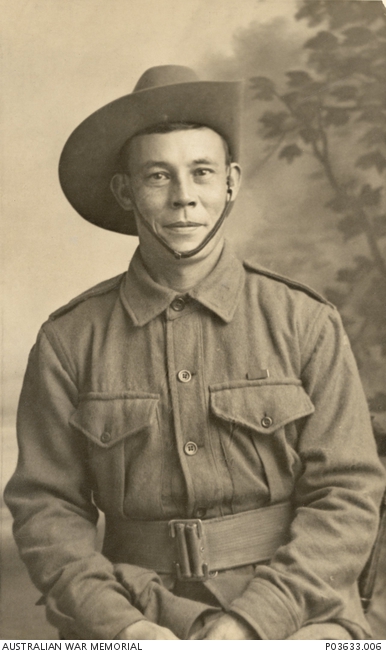 Billy Sing (Australian War Memorial)
Billy Sing (Australian War Memorial)
The influence of recent research on ethnic dimensions of Gallipoli is also seen in the inclusion in the action of Billy Sing, a Chinese-Australian sniper who is also not even mentioned in Les Carlyon’s book, Gallipoli. The need to give Tolly something special to do (and something so unusual – sniping was something done by not one man in a hundred) hints at how seven episodes really is just too long. We get more soulful silences and moody gazes into the middle distance from Tolly to pass the time, while Sing (in little more than a cameo appearance) gives him a few pointers about shooting and Life.
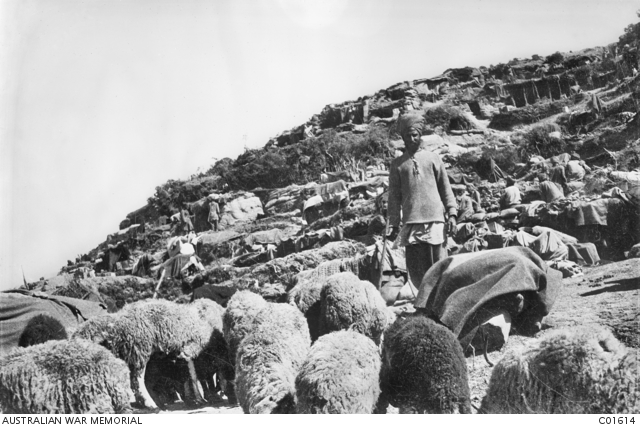 Indian soldier minding sheep supplied for rations, Gallipoli, August 1915 (Australian War Memorial C01614)
Indian soldier minding sheep supplied for rations, Gallipoli, August 1915 (Australian War Memorial C01614)
Ironically, the single most visible ‘multicultural’ aspect of Anzac is utterly invisible in Endemol’s Gallipoli. A few animals – possibly horses, though they should be mules – appear in shot occasionally. In 1915 the mules – thousands of them – were led by members of the Indian Army’s Supply and Transport Corps and at any time there were about a thousand turbanned Indians around the beach, tracks and gullies of Anzac. Many of them met and conversed with Anzacs, leading to fascinating exchanges between men who arrived as profound racists but who learned to admire men with dark skins as professional and brave regular soldiers. (I know because – you guessed it – I’ve also written a book about Indians on Gallipoli.) These men are nowhere to be seen in this Gallipoli. Since Indians constitute the fastest growing migrant group in Australia today, here was an opportunity to combine historical reality with some canny audience development. Again, this represents a failure on the part of the writer and producers to really understand the reality of Gallipoli and perhaps the hazards of using a book (Carlyon’s) that was researched over fifteen years ago.
Despite these failings, Gallipoli again gives several realistic impressions of the horrors of war. The sudden death of the larrikin Cliffie – dropped by a sniper – offers a reminder of the randomness of death in this war especially. It had to happen, of course: the survival to July of four mates was long overdue for correction. The scenes of hand-to-hand fighting in the assault on Lone Pine and of the attacks by successive lines of Light Horse at the Nek are realistic, convincing and fittingly horrific. On the other hand, the suggestion that the Wellingtons and the Turks fought with rocks on Chunuk Bair is ludicrous. The Wellingtons seem to have run out of ammunition but the Turks certainly did not.
This Gallipoli veers from horrific verisimilitude to farcical re-enactment, almost-scene-and-scene-about. The scenes of Tolly sniping, supposedly on Anzac’s southern perimeter, around Chatham’s Post, are ridiculously unconvincing, especially when Tolly drops – and recognises – the Turkish soldier (identified on IMDB as ‘Turkish Tolly’) – with whom he had exchanged souvenirs during the 24 May truce. The skill and tension – and inherent moral challenge – of sniping has been done far better, notably in Enemy at the Gates, the 2001 film based on a Russian sniper at Stalingrad.
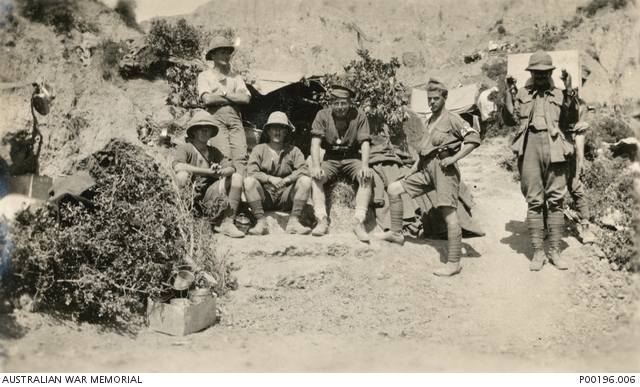 New Zealand Ambulance Corps, Gallipoli (Australian War Memorial P00196.006)
New Zealand Ambulance Corps, Gallipoli (Australian War Memorial P00196.006)
One of the greatest disappointments in this series is not just that New Zealanders don’t even appear until episode 4, but that (now they have) they are treated so poorly. Not only is there no treatment of the relationship between Australians and New Zealanders – it was sometimes tense; a gift for drama, you’d think – but the producers throw away one of the great New Zealand figures of Anzac. William Malone, the commanding officer of the Wellington Battalion, is still a household name in New Zealand. A charismatic officer (and like Simpson, Bridges and Godley British-born) Malone took over and transformed Quinn’s Post when his battalion moved into it in June. (Against Australian resistance, he made the place both defensible and habitable. The scene of Ashmead-Bartlett treading on Turkish corpses buried inches below the trench floor would not have occurred during Malone’s tenure. He had his men pick up litter from the trench floor, so fastidious was he – in contrast to the dirty and slovenly Queenslanders they replaced.) The series portrays him as a tough, no nonsense commander, but it rings false that Malone ever told Birdwood that the invaders needed to ‘kick him [“the Turk”] in the balls’. The series is doing even more poorly in New Zealand than in Australia and this further misjudgment shows why.
(If you want insights into Malone, his character and influence, get hold of John Crawford’s edition of his letters and diary, No Better Death: well worth the trouble. So popular – perhaps even revered – is Malone in New Zealand that this is the second edition of the book, and like the first it’s sold strongly. As I’ve discovered when researching in New Zealand and listening to Kiwi colleagues, there are aspects of the Anzac story of which Australians have very little understanding. This is one instance where the producers of Gallipoli have missed out on the chance to tell a genuinely Anzac story – because sadly Carlyon’s book took an Australian-Turkish view of Gallipoli, under-playing the New Zealand story; a deficiency Christopher Lee was not counselled on.)
There’s the usual crop of solecisms and anachronisms in the script: ‘way too late’ (1915 is ‘way too early’ for that one); talking about the ‘medical services’, ‘defence posts’, directing men to ‘regroup’ – that just sounds anachronistic – and the ubiquitous (in war movies), ‘Come on, men!’ Did officers in the Great War, or any war, actually call this out? There’s a thesis if not a book in battlefield cries and rhetoric. For the moment I’d just observe that in war films (like this) we often hear, not what was actually said, but what script-writers have heard in the war films they’ve seen before.
The inherent tension in the series between the story of Tolly and his mates and the larger story of the campaign is particularly apparent in the depiction of the August offensive. Lay viewers – those without a map of Anzac in their heads – may have trouble working out where’s what. Of course it probably doesn’t matter. The point of the August offensive segments – in the television series at least – is that it was a total stuff-up, and the reasons for that don’t seem necessary to give. Ultimately (in life as on television) the fault is found at the top.
The generals (still in their dry-cleaned uniforms) are of course the foils for the portrayal of the criminal folly of the August offensive, which was indeed as badly planned, co-ordinated and executed as the series makes out. The reason (in the television version) for the failure is that British generals are idiotic buffers – Frederick Stopford (61 in 1915) is portrayed by an actor aged 70, and as a doddering fool to boot. Certainly the apathetic and indecisive Stopford is one of the easier targets. But it is Hamilton who carries the can for the failure of the offensive, as is just. This production could have made him out to appear as a tragic hero: a man who did not lack nous, learning or military skill, but whose flaw was his dreadful lack of judgment of his subordinates and his inability to manage either upward or downwards. Instead it makes him look like a fool – which he wasn’t, even if he wasn’t a very good general – although it somewhat compensates for Carlyon’s scorn for Hamilton by showing (I think) that Hamilton’s curse was that he seems to have realised what a balls-up he’d made of the biggest – and last – task of his career. At least no one has suggested that Stopford was ‘making tea’ on the beach at Suvla.
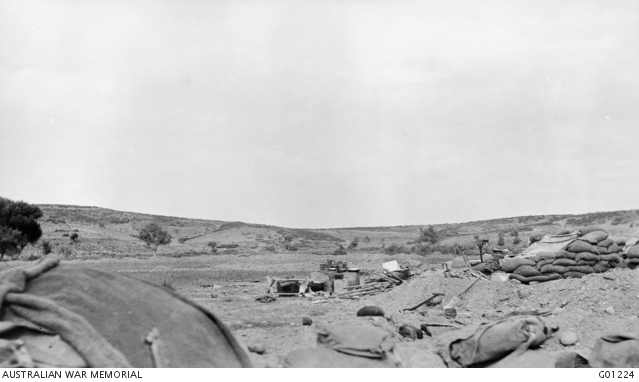 The Nek, October 1915 (Australian War Memorial GO1224/CEW Bean)
The Nek, October 1915 (Australian War Memorial GO1224/CEW Bean)
* Digger slang for the Gallipoli Peninsula. See Paul Daley’s review of Amanda Laugesen’s Furphies and Whizz-bangs.
** Professor Peter Stanley of UNSW Canberra is President of Honest History. His next book will be Die in Battle, Do not Despair: the Indians on Gallipoli, 1915, to be published by Helion & Co. UK in May.


There was an interesting article referring to the haka in the NZ Herald several days ago (April 15): https://www.nzherald.co.nz/nz/news/article.cfm?c_id=1&objectid=11432673
So many Kiwis should have got a VC at Gallipoli, but as Cyril Bassett VC famously said, “all they ever got were wooden crosses”. Godley didn’t like handing them out. Six before breakfast at Helles? NZ should’ve had sixty at Chunuk Bair alone.
Indeed he was https://www.awm.gov.au/people/P10675850/rolls-and-awards/ There was a move to get him VC as well but no go. Family legend was that only officers got them!
Ha! They’ve already depicted the obligatory ‘arm being blown off’ scene in the Lone Pine attack and very ‘Saving Private Ryan’ it was too. I’m sure we’ll be hearing lots of “we all felt bad for leaving our mates behind” monologues from Tolly in the final Ep. So gutted by this series, I really had high hopes. Was your great uncle with Throssell? Now someone should make a film on that man’s story.
I hope Hill 60 gets a run also though hoping too that my great-uncle’s arm being blown off is not too realistically covered.
Peter,
thank you for another insightful review of Ch 9’s Gallipoli, a series that has now sadly proved to be wasted opportunity to tell the story of Anzac properly.
As a Kiwi, I was fascinated to see how the series would depict Malone & his Wellingtons, but what we got were three short scenes of expository dialogue in the unrealistic looking trenches, and the most laughable depiction of the bloody fight for Chunuk Bair one could imagine.
I foolishly expected NZ troops to turn up in Ep.1 reinforcing Australian lines as they did on the 25th, fighting ‘side by side’. Where was the depiction of the Anzac spirit and mate ship between Anazc troops? Or by “Anzac”, did Lee simply mean Australian? I doubt we will see any more “NZ” in the final two episodes, even if the attack on Hill 60 is covered, and it bloody well should be!
As far as depicting the bungling Generals of the campaign, I think Alexander Godley has gotten off very lightly. The NZ & Australian Division commander was one of the true “butchers” of Gallipoli, yet we’ve hardly seen or heard from him. The Lighthorse called the Nek “Godley’s Abattoir” after the attack there, and sadly there were plenty of his abattoirs throughout Gallipoli, France & Belgium. Godley would have made a great villain!
Thanks again to you & David for being interviewed the other day, your views on “Anzackery” are being distilled into three stories that will run on TV3 over the next week or so. I’ll keep you posted.
Thank you to our two New Zealand commentators. I defer to New Zealand historians on the extent to which pakeha soldiers used or reproduced Maori motifs etc.. I know that many Maori words had penetrated pakeha usage by 1915 – when I was researching my Quinn’s Post I was forever resorting to a dictionary of Kiwi English to find out what maimai or pakapu meant (in soldiers’ diaries etc.). But I take seriously John Crawford’s opinion that there is no evidence that the Wellingtons sand a haka before attacking at Chunuk Bair – that was the portrayal in the series. I wasn’t saying that pakeha men were uninterested in Maori culture (but note, it’s ‘uninterested’; ‘disinterested’ means something else – i.e. impartial), but I think that there’s a great deal of difference between the sort of cultural association/appropriation of using Maori motifs in troopship or trench journals and having pakeha men perform a haka in that situation. Clearly the producers were projecting back on 1915 the comfort and pride New Zealanders today take in Maori culture, and I maintain that that’s not justifiable.
but can I say that I’m delighted that NZ participants are contributing to this HH forum – thank you, and we hope to hear more from you, perhaps by writing items for the website as well as commenting.
About the haka at Chunuk Bair, I don’t think it’s fair to call it an invention of the production team. Alison Fletcher’s recent article on Maori recruitment discusses the event, which she states was recounted in personal recollections of the campaign and even reported in the Times of London on August, 9 1915. (see p.64 of the article – https://journals.cambridge.org/action/displayAbstract?fromPage=online&aid=9498652&fulltextType=RA&fileId=S0165115314000539) Whether or not it actually happened, this scene was not just pulled out of thin air.
Nor is it unreasonable to suggest that Pakeha were disinterested in displays of Maori culture. There is evidence to show that Pakeha were quite used to appropriating Maori culture as a symbol for New Zealand identity during the First World War. The second issue of ‘The Athenian Lyre’ a troopship magazine produced by the first contingent of the NZEF recalls of its arrival in Hobart “We remembered and were proud of the fact that we were Maorilanders. The crowds congregated on the sidewalk were wildly excited as, marching at ease, we gave Maori war-crys and shouted Kai Oras.” (see page 2 of the digitized version published by the Auckland War Memorial Museum https://muse.aucklandmuseum.com/databases/images.aspx?fileName=F%3a%5cSerials_electronic%5cTroopship%5cAthenian+Lyre_1n2+OCR.pdf&filepathtype=unc&width=500&height=500&cmd=scaledown)
Caroly Carr, the librarian of the NZDF, presented her research on troopship magazines at a recent conference and shared a few examples of Maori imagery and motifs on the masthead of magazines produced by Pakeha reinforcement drafts. None of this should not be mistaken for cultural tolerance, however, these were clearly appropriations of Maori culture.
Thanks Peter for another riveting review.
Great to hear that the New Zealanders have finally made it to Gallipoli. While we didn’t make landfall till 9am on 25/4/15 to not appear until Ep 4 will be added to the ‘Anzac grievance file’! Agree, a missed opportunity to not explore, despite the popular sport of Trans-Tasman sledging, that huge respect and close bond solidified at Gallipoli as it was certainly mixed before the Campaign.
The whole revival of interest in Chunuk Bair and its identification with Malone is a modern attempt (as the NZ Memorial purposely built in 1920s to be seen by passing shipping) to reclaim the “NZ” in ANZAC, based on veteran testimony and advocacy by historian Chris Pugsley and novelist Maurice Shadbolt, and also a response to match Peter Weir’s Gallipoli and the climatic end at The Nek (on continual repeat in NZ each Anzac Day during the 1980s). Unfortunately the film production of Shadbolt’s play “Once on Chunuk Bair” does not compare and we patiently await Sir Peter Jackson’s long publicised desire to make his “Gallipoli” (and he rates highly Weir’s).
With regards Maori and Pakeha at Chunuk Bair. This was the Maori “Native Contingent” first combat action at Gallipoli and they were distributed amongst the NZ Mounted Brigade. I have read many accounts of Pakeha soldiers responding to the haka and this most recent account is from Dr Monty Soutar (currently writing a history of Maori on the First World War and will be speaking at AWM / ANU Gallipoli Conference this month):
Second Lieutenant Tikao of Lyttelton, who led a platoon of Ngati Kahungunu alongside the Otago Regiment, recalled that he and his men had got to within 200 yards of an enemy trench when the Turks turned their machine guns and rifles on them:
“I gave the word ‘Charge,’ my boys broke out into ‘Ka mate, ka mate’ but the yelling and screaming way they, in fact the whole lot of us, went into it must have sent a cold feeling down the Turks’ backs. In the meantime my South boys, under Captain Dansey, were charging on our right about half a mile away from us. As soon as we had cleared our first trench, when we heard them screaming ‘Ka mate, ka mate’ we knew they were at it too. This started the ball rolling, and every charge the New Zealand pakehas made that night you would hear ‘Ka mate, ka mate! Ka ora, ka ora!’”
John Crawford is correct that there are no specific accounts of Malone’s men in the Wellington Infantry Battalion responding with haka but they certainly heard them and were affected. Dan Curham recorded:
“We were told to be very quiet, not to rattle our equipment or rifles. We didn’t know how near or far the Turks were. We just knew where Chunuk Bair was. All of a sudden, in the dark, there was a very merry Haka from the Maori contingent on the seaward side of the valley up which we were travelling. My word, it startled us. Then rifles began to bang. The Maoris, it turned out, were dealing with a Turk outpost. Word came down to us that it was all right, the Turks had been wiped out, and we could proceed uphill, up a rough track leading from the sea toward Chunuk Bair”
Nor would it have been totally out of place for Pakeha to join in haka because they had been appropriating Maori cultural forms since the late 19C, most famously the All Blacks adopted the haka from 1905. The haka (war cry) was not only appropriate but stirred in Pakeha soldiers something visceral during those high adrenalin charges, also something distinctly NZ, as it still does today for the NZ Defence Force and wider society.
On language it would make a fascinating study as I am by your catalogue of anachronisms. However, plenty of quotes, by NZ soldiers anyway, recording their officers commanding “Come on” etc.
Looking forward to final “double-bill” review and the survivors getting off! It will be interesting to see what will be the parting message?
Cheers
Steve